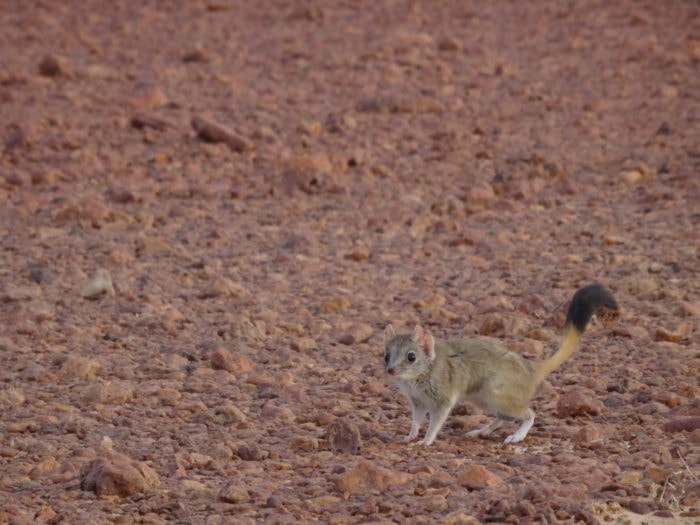The kowari is the cutest Australian animal you need to know about

AUSTRALIA’S MARSUPIALS are among the country’s most adorable animals: think Tasmanian devils, quolls and koalas. But you may not be so familiar with the kowari (Dasyuroides byrnei).
The kowari is among a group of carnivorous desert marsupials that include the equally adorable crest-tailed and brush-tailed mulgaras.
Both the mulgara and kowari are ambitious predators, considering their small size.
It’s a bizarre sight seeing such adorable animals mung down on insects and even small birds and their eggs.
The kowari is differentiated from the two different species of mulgara by its black, bushy, coarse black tail that is equal in length to its body.
The kowari is also far more elusive.

You can identify a kowari by its black, bushy tail. (Image credit: Tali Moyle)
Read more: 8 adorable Aussie desert-dwellers
Their small distribution across north-east South Australia and south-west Queensland, particularly the Sturt Stony Desert, means you’ll be hard-pressed to find one in the wild.
The Sturt Stony Desert doesn’t match the stereotypical image of a sandy, dune-covered desert. It’s covered in small red stones, making it a “gibber” desert.
Historical records suggest that the kowari was once more widespread across the desert region of central Australia, but now they’re restricted to small refuges, often on pastoral land.
A paper published by the Threatened Species Recovery Hub in 2018 warned that, while currently listed as vulnerable, the kowari may be eligible for listing on the IUCN Red List as endangered.
Team Kowari, a not-for-profit collaboration between researchers at the University of Sydney, Arid Recovery and the South Australian Government, was recently formed to raise the profile of the kowari.
Read more: Why we need a better appreciation of our desert rodents
Zoologist William La Marca, who is currently working on a kowari-focused PhD, is also leading Team Kowari and hoping to get people more familiar with the desert animal.
That such a cute Aussie animal isn’t nationally known, William puts down to its geographic isolation.
“The kowari’s distribution is very small, and a lot of their habitat is on pastoral land so it’s unlikely that your average person would come across one.
“It’s an ‘out of sight, out of mind’ kind of thing.”
William adds that the small profile of the kowari can also be attributed to the fact that no one has ever tried to push the animal into the public consciousness, which he hopes is where Team Kowari can help.
Read more: Here are 7 of our favourite desert rodents for you to gush over

(Image credit: Nathan Beerkens)
“The ultimate goal for Team Kowari would be to educate the public and get people engaged in conservation efforts,” he says.
According to William, the kowari is facing two major threats: damage to their habitat caused by pastoralism and predation by feral animals.
“There’s lots of trampling across the burrowing systems, which the kowari construct in sand mounds,” William says.
Manager of Arid Recovery Katherine Tuft, who is also involved in the project, says that in the last decade rainfall events have improved the body condition and breeding of kowaris, however the population as a whole didn’t boom.
“Nor did the species expand in range the way similar-sized animals like mulgaras did after the calicivirus dropped rabbit, cat and fox numbers from the late 1990s,” Katherine says.
Arid Recovery operate a wildlife reserve in SA’s arid north and intend on introducing the kowari to this reserve, which happens to be on the edge of their former range.
“They’re real survivors,” says Katherine. “They show you that a landscape that looks like the surface of Mars can actually support this kind of desert life.”
Find out more about Team Kowari here.




